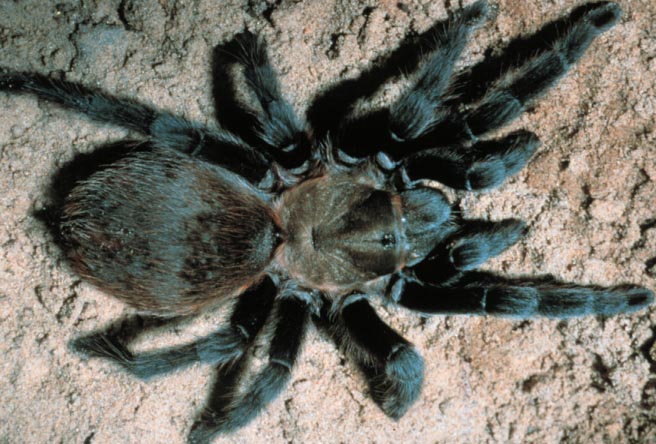
A tarantula, Aphonopelma sp. (Araneae: Theraphosidae).
Photo by Jackman.
Common Name: Tarantula
Scientific Name: Aphonopelma sp.
Order: Araneae
Description: Tarantulas are our heaviest spiders by weight and have a body length of about 1 ½ inches (40 mm). They are relatively common throughout Texas and their large size makes them quite recognizable. Typically, the head-thorax region (cephalothorax) and legs are dark brown, the abdomen brownish black. Color may vary between individuals and certainly changes after a molt.
There are 14 species of tarantulas in the genus, Aphonopelma, listed from Texas in a recent work. Identification of species is difficult and requires mature males, a microscope, proper literature and experience.
Life Cycle: Females lay 100 to 1,000 eggs in a web which is constructed like a hammock. The egg sac is retained in the burrow, guarded, and usually held by the female. Eggs hatch in 45 to 60 days. Spiderlings hatch in July or later in the year within the egg sac. Once they leave the egg sac, the spiderlings may stay with the females for 3 to 6 days or longer before dispersing. Many of the young fall prey to other spiders or predators as they disperse to begin their own burrows. Females have lived in captivity for over 25 years. Males in Texas rarely live over two or three months after maturity.
Habitat, Food Source(s), Damage: Like other spiders, tarantulas have “fangs” on the end of the chelicerae which inject venom when they bite prey. Spiders only ingest liquid food but they will chew the food somewhat while they feed. Tarantulas occur throughout Texas and are common in grasslands and semi-open areas. Tarantulas use burrows, natural cavities under logs or stones, spaces under loose bark of tree trunks and even old rodent burrows as shelters. They also dig their own burrows. Webbing is sometimes used to line the shelter and a few lines of silk are placed on the ground in front of the shelter to detect passing prey. These spiders usually are restricted to the ground but can climb. They usually remain in the burrow waiting for prey to come by but may move a few meters out to forage when necessary. They typically feed on crickets, June beetles, ground beetles, grasshoppers, cicadas, and caterpillars. One of the most spectacular spider events in Texas occurs for a few weeks each summer when male tarantulas actively wander apparently seeking females. This phenomenon is not well understood and may be related to migration more than mating.
Pest Status: Large size and hairiness of tarantulas attracts attention and concern, bites of Texas species are generally not serious to humans. When disturbed, tarantulas maneuver to face the threat and will raise up on their hind legs and stretch out their front legs in a threatening posture. When disturbed they also may rapidly brush the top of their abdomen with their hind legs which dislodges urticating hairs from the spider abdomen which irritate the eyes or skin of an attacker.
For additional information, contact your local Texas A&M AgriLife Extension Service agent or search for other state Extension offices.
Literature: Kaston 1978; Levi et al. 1990; Smith 1994; Janowski-Bell and Horner 1995.